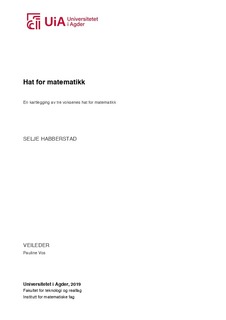| dc.description.abstract | This research is a qualitative case study with the aim to canvas individuals’ hate towards maths. Hate is not a feeling one is born with and is something that arises unconsciously as a consequence of different experiences and acts. Social factors like how one interacts with fellow pupils are therefore essential to this kind of research, and is focused upon in the sociocultural learning theory. This research also contains other feelings connected to hate. This is because hate is created by other negative feelings and what creates these feelings will therefore be examined. There is also a theoretical basis that focuses on terms like perception of one self and different mindsets; to try and understand the broader aspect of hate. Twoquestions for this research were then chosen, to try and canvas this hate. These were: •What is typical for the hate individuals have for maths?•Which possible reasons are there for this hate to have manifested? To gain insight in individuals’ hate I have chosen to perform three interviews. These interviews were made according to a interviewers guide and were finished by conversation. The subjects were asked questions where the goal was to figure out how they felt in different situations, and what they thought were the reason or reasons for their hate. In addition to this, the subjects finished a test on the internet made by Dweck (2016) and an activity where they were to choose actions and feelings from a list developed by Rempel (2018). The results showed that all three subjects had parents at home with good knowledge of maths. The challenge in all cases were that these parents were not able to explain maths to the subjects in a good and pedagogical way. This created frustration and anger. The subjects also had friends who tried to help, and two out of three speak of a culture in class where being good in school was considered cool and popular. In spite of this, none of the subjects have fared well from the knowledge of those around them. Results also show that they all thought of maths as useless, and began lagging behind the other pupils as a consequence of this. They were awarded bad grades in maths, which again created the feeling of frustration, jealousy, shame and anger. The subjects felt no senseof mastering, and the feeling of hate grew stronger and stronger. This hate can be described as a calm hate with a different way of reacting than earlier research have shown. The reason can be that hate directed at other people is felt differently than hate for objects. None of the subjects have worded a wish to kill, murder or similar extreme acts. Instead, they have felt the want to avoid and despise maths in itself. | nb_NO |

